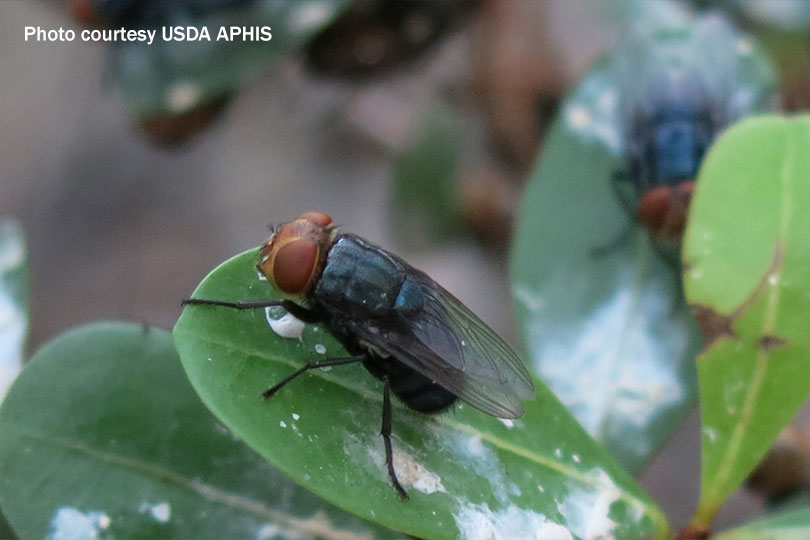A destructive parasite found in livestock and other warm-blooded animals has been identified in Mexico. The New World screwworm (NWS) was confirmed in a cow on Nov. 22, according to the U.S. Department of Agriculture’s (USDA) Animal and Plant Health Inspection Service (APHIS).
As a result, USDA placed restrictions on imports of animals originating from or transiting through Mexico.
The screwworm was found in a cow at an inspection checkpoint in the southern Mexico state of Chiapas, close to the border with Guatemala.
Texas Animal Health Commission (TAHC) is working closely with USDA to implement existing response plans to enforce pest monitoring at Texas’ southern border and into the state.
This detection follows the progressively northward movement of the pest through South and Central America. As a protective measure, animal health officials ask that ranchers along the southern border and those traveling from NWS-affected areas monitor their livestock and pets for signs of NWS and immediately report potential cases.
The USDA’s Food Safety and Inspection Service (FSIS) is the regulatory agency responsible for ensuring the nation’s commercial supply of meat, poultry and egg products is safe and properly labeled. Any evidence of screwworm infection would be identified during FSIS inspection processes, and adulterated product derived from the affected animal would not be allowed to go into commerce.
General disease information and how to prevent the spread of NWS can be found on the TAHC and USDA websites and below.
What is New World screwworm?
New World screwworms (NWS) are larvae or maggots of the NWS fly (Cochliomyia hominivorax), that cause the painful condition NWS myiasis. NWS flies lay eggs in open wounds or orifices of live tissue. These eggs hatch into dangerous parasitic larvae, and the maggots burrow or screw into flesh with sharp mouth hooks. The wound can become larger, and an infestation can often cause serious, deadly damage. NWS primarily infest livestock, but can also affect other mammals, including humans, and birds.
The parasite was last eradicated from the United States in 1966, with costly efforts by federal and state animal health officials, livestock producers and veterinary practitioners. Eradication efforts have continued in Central America, but the pest is considered endemic in Cuba, Haiti, the Dominican Republic and South America.
Clinical signs
Clinical signs of NWS myiasis may include:
- Irritated or depressed behavior
- Loss of appetite
- Head shaking
- Smell of decaying flesh
- Evidence of fly strike
- Presence of fly larvae (maggots) in wounds
- Isolation from other animals or people
Transmission
NWS infestations begin when a female NWS fly is attracted to the odor of a wound or opening of a live warm-blooded animal to lay eggs. These openings can include wounds as small as a tick bite, nasal or eye openings, umbilicus of a newborn, or genitalia.
One NWS female fly can lay 200-300 eggs at a time and may lay up to 3,000 eggs during her lifespan.
Eggs hatch into larvae (maggots) that burrow into an opening to feed. After feeding, larvae drop to the ground, burrow into the soil, and emerge as adult NWS flies. Adult NWS flies can fly long distances, and the movement of infested livestock or wildlife can lead to spread of even longer distances.
Diagnosis
There are several flies associated with wounds, but only NWS feed on living tissues, versus dead tissues and fluids. The identification of NWS is done by larvae collection and evaluation. NWS larvae have a series of backwardly protruding spines around a tapered body, giving a screw-like appearance, helping to identify the pest.
Anyone who suspects suspicious wounds, maggots, or infestations should notify a veterinarian immediately.
Reporting New World screwworm
TAHC must be notified within 24 hours of all suspected and confirmed cases of NWS. Reports can be made to any TAHC region office by anyone, not just veterinarians or diagnostic laboratories. Suspected infestations of NWS should be immediately reported.
Prevention
To avoid introduction of NWS, keep open wounds clean and covered and treat clothing, gear,\ and people with proper repellents. When traveling, especially in NWS-infested areas, ensure pets and vehicles are inspected for NWS flies and larvae. Monitor pets and livestock for clinical signs of NWS and immediately report suspicions.
Treatment and eradication
Animals infested with NWS, myiasis or secondary infection should be immediately treated with an appropriate method by a veterinarian. Left untreated, animals may die within one week of infestation.
Eradication of NWS infestations is accomplished through the sterile insect technique. Sterilized male flies are released to mate in an area with an established NWS population. Females, only mating once in their lifetime, then lay nonviable eggs. The population decreases without the addition of new larvae and dies off naturally over a few lifecycles.
Additional New World screwworm information and resources
- Texas Animal Commission: New World Screwworm Fact Sheet
- Animal Health Resources: United States Department of Agriculture Animal and Plant Health Inspection Service, New World Screwworms
- Human Health Resources: U.S. Centers for Disease Control and Prevention, New World Screwworm Myiasis


Leave A Comment